

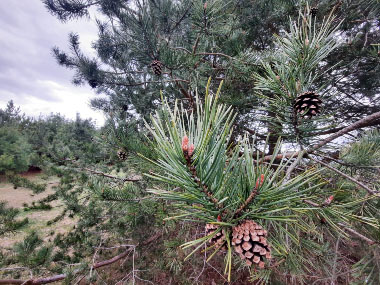
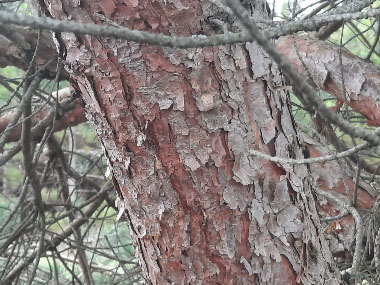
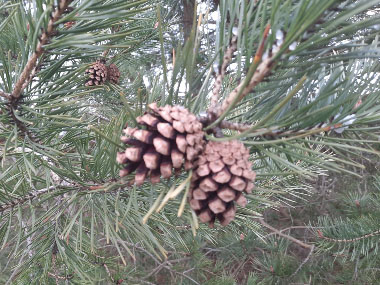
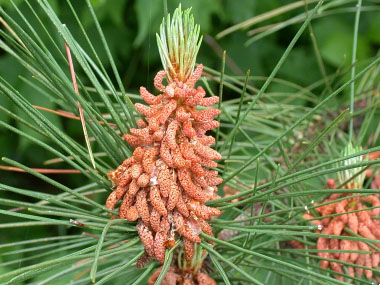
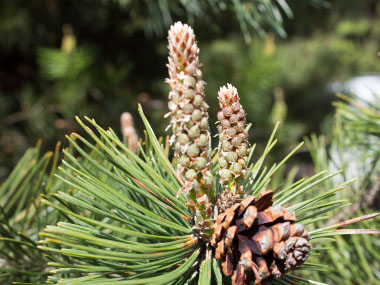
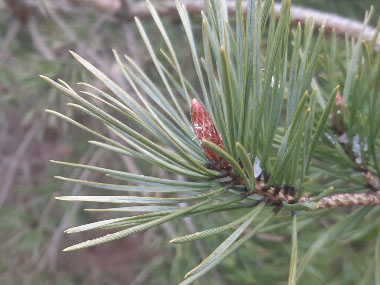
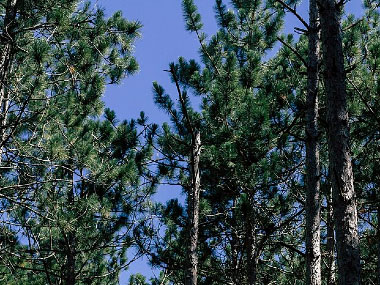
To support our efforts please browse our store (books with medicinal info, etc.).
Red Pine can be easily identified because of the reddish bark and the needles. Red Pine needles grow in pairs and are long. It is native to northeastern U.S. and Canada. In the Upper Midwest of the U.S., it is sometimes known as the Norway Pine even though it is not native to Norway. Interestingly, it is the state tree of Minnesota. The Cree call it Nikwátiko; Ojibwe call it Zhingwaak Bapakwanagemag; and the Dakota call it Wazichan. Red pines can live up to 500 years. This tree is a slow to medium grower, about 30cm (1') per year. Red pine has deep and widespread root systems allowing it to withstand strong winds. Red Pine resembles the Eastern White Pine in their overall form when young. The main difference when viewed from a distance is that the Red Pine is brushier.
Trunk/Bark
The bark is reddish-brown when mature, flaky; eventually becoming plated as it matures. The plates have scaly surfaces with a reddish tinge. A fully mature tree's trunk diameter can be 1 m (3').
Branches/Twigs
They are medium textured, orange-brown in color with narrow, ovoid orange-brown buds up to 2 cm (3/4") long with many reddish-brown scales with tips turned back.
Height
The red pine reaches a height of 27 to 30 meters (90 to 100') when grown in natural conditions. The trunk diameter can grow to 30 to 40".
Leaves/Needles
Needles grow 10 to 16 cm (4 to 6") long, there are two needles per fascicle (clusters of two with a brown sheath at the base).
Flowers
Red pine is monoecious; males are almost round, light red, and in large clusters at branch tips. Females are round, have a short cone, and are reddish brown. Flowers appear during spring; pollination takes place during May-June, and the fertilization occurs in mid-July the following year.
Fruit
Cones are ovoid, 4 to 7cm (1.5 to 2.5") long. They are shiny chestnut brown and mature in early summer.
Habitat
Red pine typically grows on well-drained, acidic, dry sandy soils. This area may include outwash plains, ice contact features, rock outcrops, and dunes. They can also be found in forests.
Edible Parts
Pines actually have a number of edible parts. Historically, young, male cones were boiled and eaten. Pine pollen can be used in a number of ways by adding it into many dishes. The needles can be used as a tea - or dried, ground into a powder and then used in baking. The cambium of all pine trees can be eaten either raw, boiled or fried. This should be only in a survival situation.
Other Name
Norway Pine.
Recipes
Winter Survival Food Handbook

PDF Plant Magazines
Types of Wild Food
Geographic Zones Seasons
Disclaimer
EdibleWildFood.com is informational in nature. While we strive to be 100% accurate, it is solely up to the reader to ensure proper plant identification. Some wild plants are poisonous or can have serious adverse health effects.
We are not health professionals, medical doctors, nor are we nutritionists. It is up to the reader to verify nutritional information and health benefits with qualified professionals for all edible plants listed in this web site. Please click here for more information.
Why Edible Wild Food?
- Food costs are rising
- Free, wild food is readily abundant
- Wild food adds nutrition to your diet
- Wild food can help treat various medical conditions





